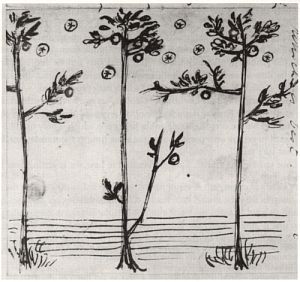
Design for Wallpaper
Dante Gabriel Rossetti
1861
Production Description
Production Date: 1861

Electronic Archive Edition: 1
File Name:
sa832.rap.xml

Scholarly Commentary
Introduction
DGR's design for wallpaper appeared in a January 1861 letter to William Allingham. DGR intended the paper to enhance the drawing-room at Nos. 13 — 14 Chatham Place, the address which he and EER had taken shortly after their marriage: “Our drawing-room is a beauty . . . we shall have it newly papered from a design of mine which I have an opportunity of getting made by a paper manufacturer somewhat as below. I shall have it printed on common brown packing paper and on blue grocer's paper, to try which is best.” After reproducing the wallpaper design for Allingham in a rough pen and ink sketch, DGR went on to anticipate the special aesthetic effect which the finished room would have upon its visitors: “The trees are to stand the whole height of the room, so that the effect will be slighter and quieter than in the sketch where the tops look too large. Of course they will be wholly conventional. The stems & fruit will be Venetian Red—the leaves black. The fruit however will have a line of yellow to indicate roundness & to distinguish it from the stem. The lines of the ground black. And the stars yellow with a white ring round them. The red & black will be made of the same key as the brown or the blue ground so that the effect of the whole will be rather sombre but I think rich also. When we get the paper up we shall have the doors & wainscotting painted summer house green” (Fredeman, Correspondence 61.5). Had it been produced, the wallpaper would have complemented the sense of a hushed, embowered space so often remarked upon by visitors to DGR and EER's home.
Production History
No evidence of the wallpaper's production exists. Nevertheless, DGR's elaborately imagined design bears witness to his heightened attention to domestic crafts at this time. His interest was at once personal and professional. In November 1860, DGR and his wife, EER, had left their accomodations at Spring Cottage in Hampstead and relocated to the cheaper, less-desirable lodgings at Nos. 13 and 14 Chatham Place, at Blackfriars. DGR expressed concern that the Chatham Place rooms would not facilitate EES's recovery, and he went to great lengths in order to make his “old quarters” more comfortable for her (see Fredeman, Correspondence, 62.3). In addition, several other young couples within DGR's circle were also setting up their homes; the January 1861 letter to Allingham makes it clear that William Morris's innovative decorations at Red House had especially impressed DGR: “However you have yet to see a real wonder of the age—viz:Topsy's house which baffles all description now” (Fredeman, Correspondence 61.5). Finally, and crucially, the Firm of Morris, Marshall, Faulkner & Co. was formalized in April 1861 in order to facilitate decorative projects such as DGR's design for wallpaper.
Iconograpic
DGR's wallpaper design shows the artist realizing new aesthetic possibilities for domestic space. The arboreal design recalls the pictorial background in several of DGR's pictoral works; it can be viewed alongside St. George and the Princess Sabra (1862) and, especially, Regina Cordium (1866), where the tree motif, though fuller in size, closely resembles the 1861 design for wallpaper.
Autobiographical
DGR and EES were married on 23 May 1860. Following a short stay at Spring Cottage in Hampstead, the couple relocated to a less-desirable urban address in Blackfriars, where rooms previously taken by DGR had been expanded to include the second floors of No. 13 and 14 Chatham Place (Fredeman, Correspondence, 60.46).
As the letter to Allingham attests, DGR worked hard to make the Blackfriars living space more comfortable for his bride. However, DGR openly expressed his disappointment with having to move EER back to the London rooms, confessing “the conviction that they cannot be best for her health” (Fredeman, Correspondence, 62.3). The design for wallpaper may be viewed within the context of these hopes and these doubts, showing the artist deploying the full resources of his imagination as a counter against his less-than-ideal surroundings.
Bibliography